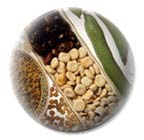- Home
- Introductions

|
Vegetable Seed Production:You are here: Seed Production: Poaceae: Sweet Corn
Botany Corn is a monoecious warm season annual that is intolerant of frost. Male flowers are borne on the top of the plant (called the tassel) while female spikelets are borne separately lower on the plant attached to the main stalk (called the ear). Female flowers are in terminal inflorescences enclosed in husks.
Soil Nutrition Sweet corn has a relatively high nutrient requirement. Sufficient nutrients should be available early in the season to ensure rapid growth and good stand establishment. The crop responds well to nitrogen and nitrogen fertilization varies widely depending on soil type. Generally more nitrogen is used on light sandy soils than heavier silt or clay loam soils. Sidedressing with nitrogen is common with corn. Many large growers row band some nitrogen at planting and then sidedress with anhydrous ammonia when the corn is knee high. Anhydrous ammonia is a pressurized gas that is 82% N. The gas is injected to the soil where it reacts with water to form the ammonium ion which is attracted to negatively charged particles in the soil. It is very important to use anhydrous ammonia in moist soils to reduce losses from volatilization. Other forms of nitrogen can be used in areas where anhydrous ammonia is not available. Phosphorus and potassium fertilization is usually based on soil test results and in some areas of the West and Midwest applications are not needed every year depending on the soil type and the crop rotation schedule. Generally, all of the potassium and phosphate are row banded at planting. Isolation The male flowers ("tassels") are in a terminal inflorescence and
the female flowers ("cobs" or "ears") are borne on lateral
branches. There is a tendency for dehiscence of pollen up to two
or three days in advance of the stigmas becoming receptive, which
increases the incidence of cross-pollination. Planting Corn can grow on a wide range of soil types ranging from sandy loams to clay loams. Lighter soils are often selected for earlier plantings because they warm up faster in the spring while plantings for late market are often placed on heavier soils. Some sweet corn production in Florida occurs on muck soils. Good drainage is important regardless of the soil type. The best yields take place at a pH of 6.0-6.8 although the crop grows fairly well over a wider pH range of 5.5 to 7.5. Acid soils with pH below 5.5 should be avoided. Irrigation Sweet corn has a shallow fibrous root system with most roots in the top 2 feet of the soil. Consequently, it is important to keep adequate moisture in the top 2 feet of the soil especially during stand establishment and early season growth. Drought stress will delay maturity and cause uneven harvest. Drought stress during tasseling will cause poor tipfill thus reducing both yield and the appearance of the ears. Supplemental irrigation or rainfall totaling at least one inch per week is required for early growth and during tasseling. Tightly rolled leaves early in the morning is an indication of significant drought stress Overhead sprinkler and furrow irrigation are used for sweet corn. Furrow irrigation is limited to areas primarily in the western US where the land is level enough to be graded. Roguing Both parents must be inspected if hybrid seed is being produced
and roguing criteria applied according to the description of each
parent line. Roguing is not normally done in stages but attention
must also be given to detailed descriptions provided by plant
breeders of likely off-types. The roguing operations must be
completed before male or female inflorescences are fully
developed.
Seed Harvest Clear instructions must be given to harvesting gangs regarding the disposal of seeds from male lines before the main harvest commences. The cobs of the main seed crop are harvested when the seeds" moisture content is down to 45 per cent or slightly less. Visual signs of this stage are the glazed appearance of seeds as they harden. Small areas are harvested by hand but specialists in the USA either use mechanical pickers or direct combining. Further post-harvest drying of cobs is done in bird- and rodent-proof cages known as "cribs", or the cobs are dried artificially. Cleaning Seeds are not removed from cobs (usually called "shelling") until
the seeds" moisture content has reduced to 12 per cent.
The husks have to be removed from the cobs before the shelling
operation which also provides a post- harvest check of genetical
quality and an opportunity to discard cobs displaying diseased
seeds. Seed Yield The seed yield depends on the cultivar and, if hybrid seed is
produced, the proportion of plants cultivated as the female
parent. Yields of 1500 kg/ha (1338 lb/acre) are generally obtained
although specialist producers in the USA obtain up to 2500 kg/ha.
(2230 lb/acre) Seed Identification:
|
||||||||||||||||||||||||